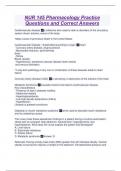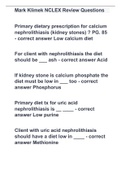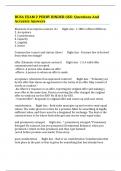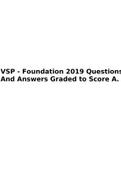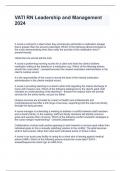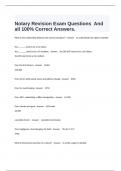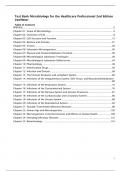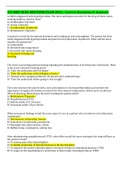Questions and Correct Answers
Cardiovascular disease ✅a collective term used to refer to disorders of the circulatory
system (heart, arteries, veins) of the body.
*Major cause of premature death in the United States.
Cardiovascular Disease - Subdivided according to organ ✅Heart
-Coronary artery disease, angina pectoris
-Myocardial infarction, dysrhythmias
Brain
-Stroke
Blood vessels
-Hypertension, peripheral vascular disease (both arterial
and venous disorders)
**Long-term pathology of any one or combination of these diseases leads to heart
failure.
Coronary artery disease (CAD) ✅a narrowing or obstruction of the arteries of the heart
Metabolic Syndrome ✅Causative factors that lead to cardiovascular disease.
Key characteristics
-Presence of type 2 diabetes mellitus
-Abdominal obesity
-Hypertriglyceridemia
-Low high-density lipoproteins (HDLs)
-Hypertension
Lifestyle is greatest contributor
Diabesity or insulin resistance syndrome ✅terms used to describe insulin resistance
and its underlying causes.
The nurse notes these assessment findings in a patient during a routine examination:
obese with an enlarged, fatty abdomen; hypertension; hyperglycemia; and
hyperlipidemia. What does the nurse suspect the patient has developed?
A. Liver failure
B. Electrolyte imbalance
C. Kidney failure
D. Metabolic syndrome ✅Answer: D
Rationale: Having a body mass index (BMI) greater than 25 indicates obesity. Central
obesity is having the majority of weight in the abdomen. Elevated blood pressure and
, blood sugar are also classic signs of metabolic syndrome. People with central obesity
and two of four other criteria are said to have metabolic syndrome.
Risk factors of Metabolic Syndrome ✅-Poor diet—convenience foods, fast food
-Sedentary lifestyle—contributes to overweight and obesity
-Excessive alcohol consumption
-Smoking
-Work-related stress
-Genetic predisposition
-Body mass index (BMI)
-Weight in proportion to height
*BMI is measured by weight in kilograms divided by height in meters squared—OR—
weight in pounds multiplied by 703 and divided by height in inches squared.
What percentage of Americans are not regularly physically active?
A. 30%
B. 40%
C. 50%
D. 60%
E. 70% ✅Answer: D
Rationale: Today, despite common knowledge that regular exercise is healthy, more
than 60% of Americans are not regularly physically active and 25% are not active at all.
Changes in society in the workplace and time-saving devices have made it less
necessary for people to physically work or walk. These facts, along with excessive diets
and other risk factors, place many Americans at a significantly higher risk for the
development of cardiovascular disease and premature death.
Certain factors place us at risk for development of cardiovascular disease. Which one is
a non-modifiable risk factor?
A. Weight
B. Smoking
C. Cholesterol level
D. Blood pressure
E. Family history ✅Answer: E
Rationale: Each of the above factors is significant in the development of cardiovascular
disease. By keeping them in normal range, we significantly decrease our personal risk
for the development of cardiovascular disease. However, the things we cannot change
are our age, gender, family history, and personal history.
In the central United States, what percentage of the population is considered obese?
A. 10% to 14%
B. 15% to 19%
C. 20% to 24%

